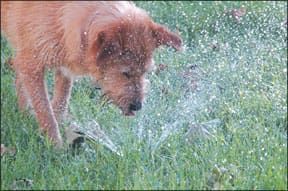I can’t believe it’s been a more than a year already since I brought Otto home from a shelter. The date was June 16, 2008. There were actually two dogs I was considering at the shelter, and I thought I might bring the other one home for a night, too; I wanted to make sure I had absolutely the right dog for me and my family. But Otto was “the one.” He’s developing into everything I could want in a dog – no small part, I think, due to all the positive training work we’ve put into him over this past year. I can confidently testify, “Folks, this stuff really works!”
A year of progress
I haven’t managed to do half of all the things I planned to do with Otto in his first year with us – and yet, he’s doing incredibly well. Our major accomplishments?
He hasn’t chewed anything he wasn’t supposed to chew for months and months. Okay, he’s about 20 months old now; he’s not teething like he was. But he’s also had a steady supply of appropriate chew toys – and ones that he showed he liked. There is no use in buying a bunch of toys for your dog if you don’t pay close attention to what the dog does and does not like! With the exception of one rubber “stick,” Otto doesn’t like chewing on rubber toys or Kongs (except for the Kong with a squeaker in it; he loves anything with a squeaker). Same with plastic chews. He likes stuffed animals with squeakers, actual wooden sticks (and pieces of scrap lumber), rawhide chews, and fresh raw meaty bones. That’s about it.
I’ve found that it’s important to rotate his chew toys, picking all of them off the lawn and deck at least once a week, and doling out a fresh one or two a day. If they are all laying around all the time, he loses interest in them. But he’s newly enthusiastic when I dole out a chew he hasn’t seen for a few days.
His barking is mostly limited to a few, appropriate barks, such as those that alert us to the arrival of the mail or UPS, or to a passing “suspicious person” (such as someone lurking near our cars, or a late-night stumbling drunk).
This has taken quite a bit of work. We rarely leave Otto out in the yard when we’re not home, so he almost never gets an opportunity to “practice” nuisance or boredom-barking. My husband and I both work at home, and when we hear Otto bark, one or the other of us always investigates, acknowledges Otto, and calls him to us for a pet or a treat. He’s learned that coming straight to us is consistently rewarding, and so he “calls off” of anything he’s barking at very easily.
He’s far more confident with strangers than he used to be. This, too, has taken a lot of work. I enrolled Otto in two six-week classes with a wonderful local positive trainer, Sarah Richardson, CPDT. (I’ve been meaning to sign up for a tricks class, or beginning agility, but just haven’t found the time!) I’ve taken Otto to dog parks, people parks, friends’ homes, and businesses where dogs are welcome.
My friends can attest that I’ve had a “bait bag” full of training treats fastened around my waist just about every day this year, so I could classically condition him to the sight (and then the presence) of strangers. I ask practically everyone we meet to give him a few treats. Now his tail starts waving and his expression brightens when we see someone coming toward us on a sidewalk or trail!
He readily turns away from “forbidden pleasures” such as stray cats crossing the sidewalk in front of us or the carcass of a dead animal on the side of the trail. I make sure I always have high-value treats for reinforcing Otto when it really counts, and it’s paid off in spades.
Just the other day, as I was biking with him on a trail – and he was off-leash – we spotted a raccoon eating from a pile of cat food that someone left for feral cats. Unlike them, the raccoon did not run away from the pile as we approached; growling and snarling, it backed into the bushes a little bit. The moment Otto spotted it, though, from a distance of about 100 feet, he turned his head and fixed his eyes on me. I sped up, while verbally confirming that he was doing exactly what I wanted him to do: “Good dog, Otto! Yes! Good boy!” and Otto kept his eyes on me, even as we raced past the raccoon and the cat food. When we were about 100 feet or so past the raccoon, I stopped my bike and fed him a jackpot of about, oh, I don’t know, maybe 50 pieces of hot dog! I was bursting with pride!
He’s rock-solid with other dogs. I can’t take all the credit for this; Otto was already very friendly and playful with other dogs when we got him. But I’ve taken pains to maintain this trait, by giving him lots of opportunities to play with other nice dogs and puppies, at my and friends’ homes, at the dog park, and in occasional doggie daycare sessions. He’s also gotten to play with some not-so-nice dogs, and he’s been unflappable with them, too, even after getting rolled over or pushed around. I limit his exposure to playmates who have “issues,” though, to preserve his good attitude toward and interest in other dogs.
Work still to be done
This is not to say that Otto is perfect! We still have some work to do. This is what I’m working (or planning) to improve in the immediate future:
He’s still “iffy” with kids; he sometimes growls quietly and turns away from small children. Now that my son (and all of his friends) are older teens, I don’t have a steady supply of small kids to expose Otto to. And with a baby niece about to be born, I have to get on the job! We live across the street from a YMCA, though. I’m thinking that this summer, I’m going to make it a habit to sit with Otto on the sidewalk outside when swimming lessons are getting out, and ask kids if they’d toss Otto a few treats.
He is afraid of slick floors, like the polished concrete floors in pet supply stores. This one is weird. Sometimes he’ll go right across a slippery floor; on other occasions, he’ll suddenly freeze and, panicky, try to flee the floor as quickly as he can. I need to work on desensitizing him to slick floors.
If he gets very afraid of something, he “checks out” and won’t come to us. Recently, my husband took Otto fishing on a stream in the mountains near here. The trip entailed wading across rushing whitewater several times. Otto likes wading, but not swimming, and once he ascertained that this water was deeper and faster than he felt confident about, he dug in his heels.
The first time this happened, Brian just pulled him into the water by his leash; once he was half-way across, he leaped for the other side. The next time Brian prepared to cross, Otto was ready. He ducked his head, pulled back, and neatly slipped his martingale (“no-slip”!) collar over his ears.
Afraid the collar was coming off, Brian dropped the leash, and Otto took off upstream, looking for his own way across the water. Worried that he had lost the dog, Brian waded back across, calling Otto – who reappeared without collar or leash (and tags). The rest of the day sounded like a trial for both of them.
Worse, the avoidant behavior recurred. A few days later, I called Otto to me as I watered some plants in the garden. He took one look at the hose, (wrongly) guessed at a possible bath in the works, and took off to hide on the far side of the house.
I plan to work hard to extinguish this behavior; I don’t want him to even consider the option of running away from us in a stressful moment. We need to go back to square one with our recalls.
Once they are solid again, we’ll work on recalls in the face of distractions and even scary things, using a long-line if we need to make certain he can’t run away. The goal will be to rebuild his confidence in the concept that coming to us is always a better option than pulling or running away.





